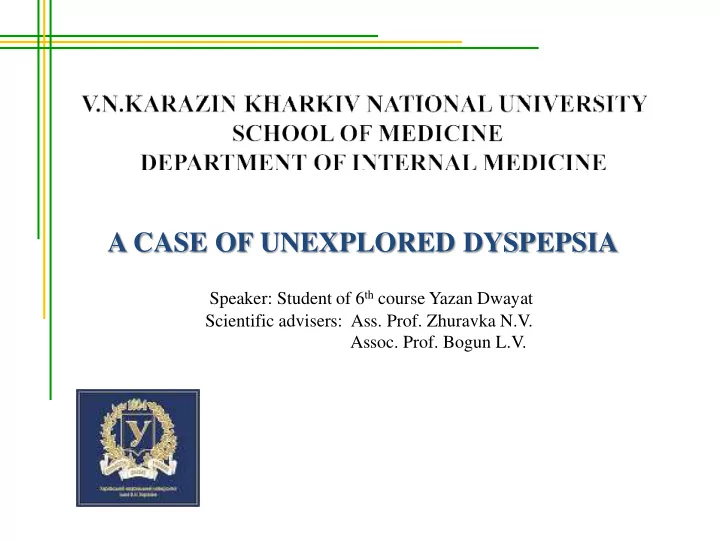

A CASE OF UNEXPLORED DYSPEPSIA Speaker: Student of 6 th course Yazan Dwayat Scientific advisers: Ass. Prof. Zhuravka N.V. Assoc. Prof. Bogun L.V.
Introduction Dyspepsia is a chronic disorder of sensation and movement (peristalsis) in the upper digestive tract. Based on modern concepts, dyspepsia should be interpreted in two ways - either as a syndrome or as an independent nosological form. To designate dyspepsia as a preliminary diagnosis, that is, to describe a dyspeptic symptom complex in a primary patient, it is recommended to use the term “unexplored dyspepsia” . This primary syndromic diagnosis requires either empirical symptomatic or anti-Helicobacter pylori treatment, or further examination of the patient, especially esophagogastroduodenoscopy (EGDS) in order to establish organic or functional causes of dyspepsia.
Our Patient Name: I.K.V. Gender: male Age: 48 years old Occupation: railway worker Admitted to the hospital #5 on 29th of December 2018
Complaints constipation up to 5 days; pain in the upper abdomen, that decreased after eating; feeling of bloating in the epigastric region after eating; 12 kg weight loss since April 2018.
Anamnesis Morbi Main complaints were felt 8 months ago Repeatedly examined by a gastroenterologist Last exacerbation was 1 weak ago, he didn’t take any drugs After consulting with the physician patient was admitted to the hospital (29.12.2018) for further observation and tests Anamnesis Vitae Anamnesis vitae is unremarkable
Physical examination 1 Temperature 36,7 o C PS 78 bpm (both hands) BP 130/80 mm Hg (both hands) Respiratory rate 18 pm Height 168 cm Weight 67 kg BMI 23, 7 kg/m2
Physical examination 2 General condition: His mood, orientation in space, posture and development are normal. Musculoskeletal system examination is unremarkable. Peripheral lymph nodes are not palpable. The thyroid gland is not palpable. Skin and mucous membranes: Skin, subcutaneous fat tissue, nails, mucous membranes, are normal.
Physical examination 3 Gastrointestinal system: The tongue is wet, at the root is coated with white bloom. On auscultation, the abdominal intestinal peristalsis saved, On palpation, abdomen is soft, painless, symmetrical, no discrepancies of the abdominal muscles. Stool - a tendency to constipation, last stool 2 days ago with a laxative. liver edge is smooth, painless, palpated 0.5 cm below the costal arch; spleen and pancreas are not palpable. The rest of physical examination is unremarkable.
CBC (30.12.18) Parameters Result Normal range Hemoglobin 152 M 130 - 160 g/ l Erythrocytes 4,81 M 4,0 - 5,0 T/ l 35 – 47 5% Hematocrit 44,3 4,0 – 9,0 g/L Leukocytes 4,8 ESR 2 M 2-15 mm/h Stab neutrophils 1 1-6 % Segmented neutrophils 63 47-72 % Eosinophils 0 0,5-5,0% Basophils 0 1-1,0 % Lymphocytes 32 19-37% Monocytes 4 3-11 % Platelets 190 180-320 g/L
EGDS (02.01.19 ) С hronic superficial antrum gastritis. Papular antral gastropathy 1 degree.
Colonscopy(28.08.18) Dolicho-sigma , hypomotor syndrome.
Abdominal CT scan (30.10.18) Pathological lesions in the projection of the stomach and intestinal loops are not defined. (norm)
Clinical Diagnosis Unexplored dyspepsia, postprandial distress syndrome, epigastric pain syndrome. Irritable bowel syndrome with constipation with colon dyskinesia of hypomotor type.
Pharmacological Treatment Omeprazole 20 mg twice a day, domperidone 10 mg thrice a day. Taking into account the presence of “ red flag ” such as significant mass loss in association with non-conclusive results of EGDS we highly recommend patient to undergo EGDS with biopsy and rapid urease test to confirm the diagnosis of chronic gastritis and clarify its type in order to prescribe optimal therapy.
Conclusion Dyspepsia is a common, long-recognized condition with a number of upper abdominal symptoms. But diagnosing this condition requires exclusion of organic diseases of digestive tract.
THANK YOU FOR ATTENTION!
Recommend
More recommend